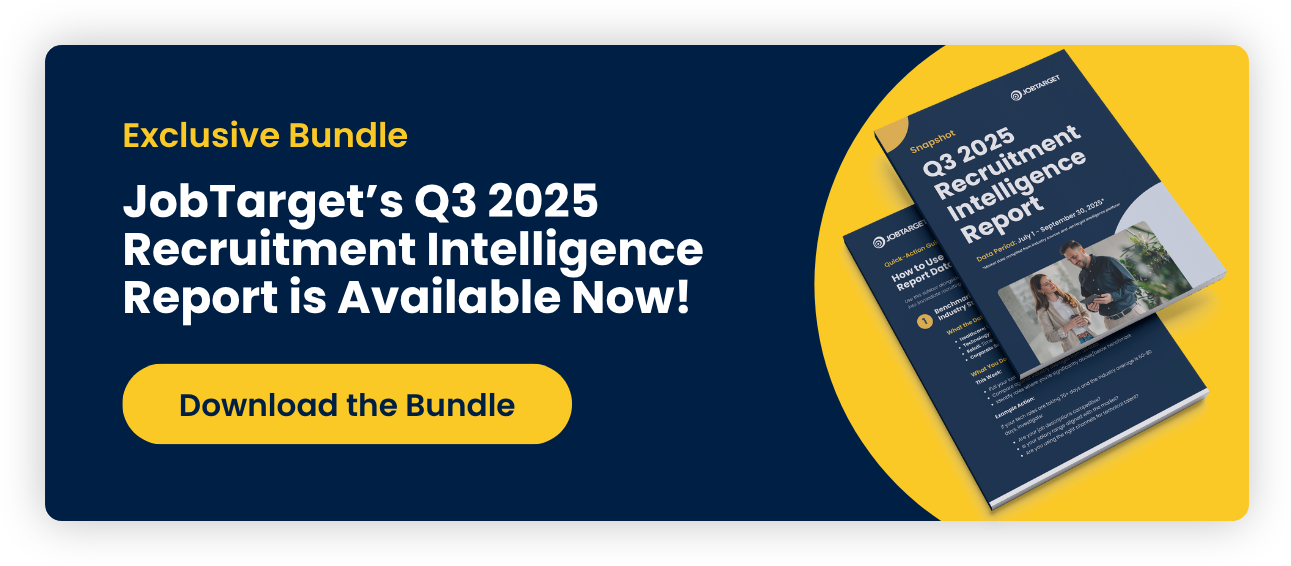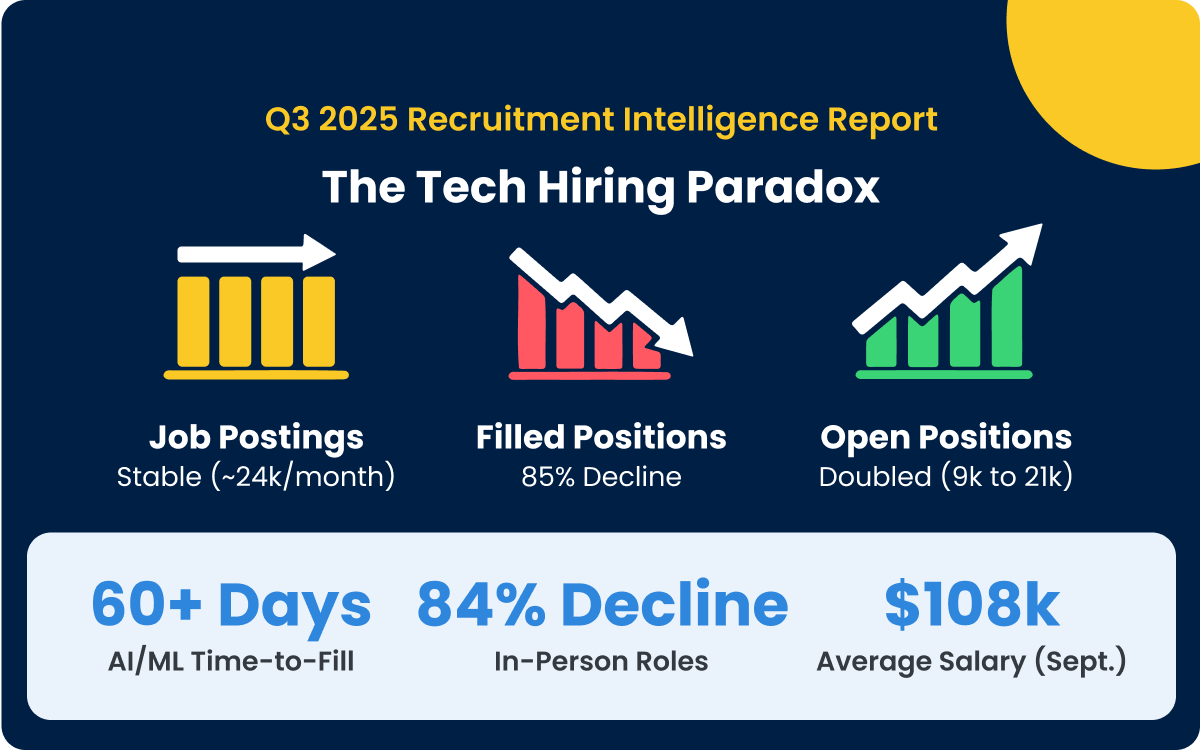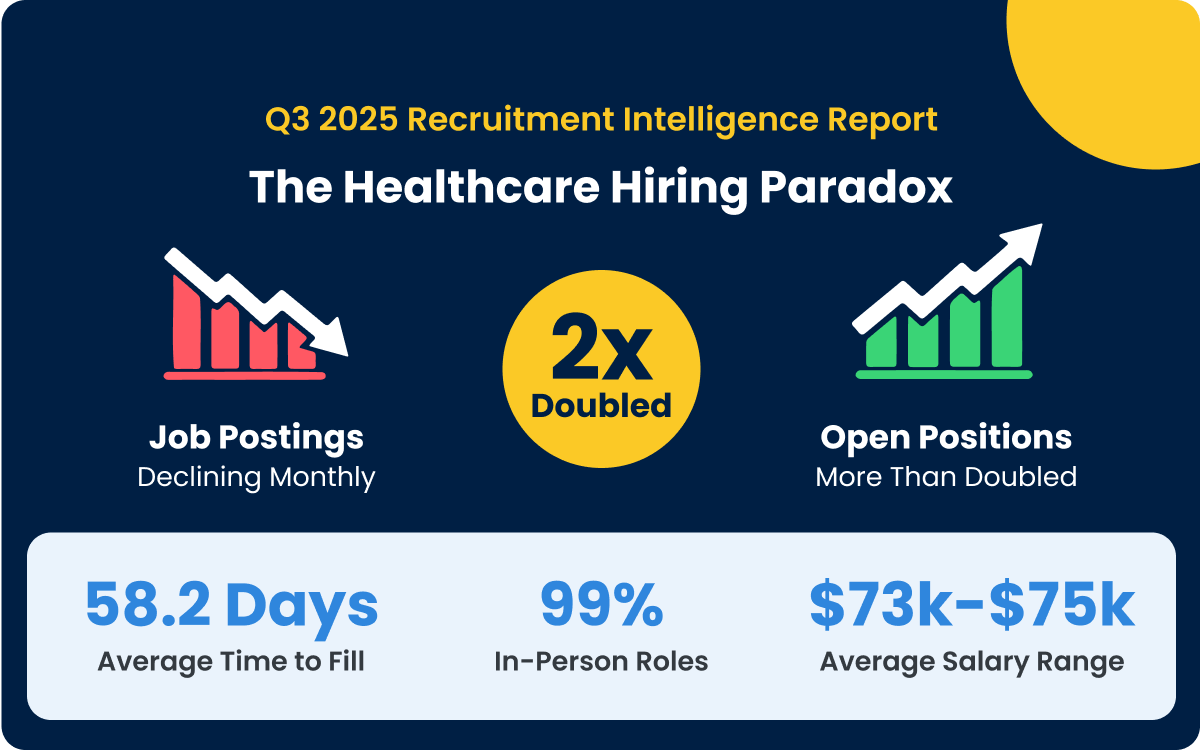Executive Summary
Retail recruitment experienced dramatic volatility in Q3 2025 as organizations navigated seasonal planning, wage pressure, and unpredictable candidate availability. Job postings fluctuated wildly—252K in July, 239K in August, slight September rebound—while open positions surged 51% and filled roles plummeted from 113K to 33K. Yet retail achieved rare improvement: average time-to-fill dropped from 95 to 67 days, and reposting frequency fell from 39% to 12%.
Key Q3 Retail Findings:
- Job postings volatile: 252K → 239K → slight rebound
- Open positions surged 51% through quarter
- Filled positions dropped 113K → 33K
- Average salaries climbed steadily $47K → $52K (10% increase)
- Time-to-fill improved 95 → 67 days (rare Q3 gain)
- Reposting frequency dropped 39% → 12% (better targeting or market pullback)
- Nearly 100% on-site roles (minimal flexibility)
This data, compiled from JobTarget's comprehensive recruitment intelligence platform, reveals both immediate tactical opportunities and longer-term strategic implications for retail hiring teams navigating an increasingly complex talent landscape.
Market Dynamics Through Q3
The Volatility Story
- July (252K postings):
Peak summer hiring for back-to-school season and early holiday preparation. Retailers competing aggressively for talent ahead of critical Q4. - August (239K postings):
5% decline as initial hiring waves completed and some retailers pulled back on ambitious plans. Economic uncertainty drove conservative approach. - September (slight rebound):
Holiday hiring acceleration began as retailers finalized Q4 staffing strategies. Those who delayed August hiring scrambled to catch up. - What This Means:
Retail recruitment operates in rapid cycles. Organizations that staff proactively in July avoided September desperation. Those waiting faced tighter candidate pools and wage inflation.
The 51% Open Position Surge
Despite posting volatility, unfilled positions exploded—surging 51% through the quarter. This disconnect signals:
- Candidate Scarcity: Labor pool insufficient to meet demand, particularly for experienced retail workers and specialized roles (visual merchandising, inventory management, customer service leads).
- Wage Sensitivity: Candidates evaluating multiple retail offers simultaneously, choosing highest-paying or most flexible options. Posted positions without competitive wages stayed open longer.
- Application Quality Issues: High application volume didn't translate to qualified, interested candidates. Retailers faced sorting through unqualified applicants to find viable hires.
Quarterly Salary Progression
10% Wage Growth Through Q3
Average retail salaries climbed steadily from $47K to $52K—a 10% increase in 90 days. This aggressive wage growth reflects:
- Competitive Pressure
Retailers bidding against each other for finite labor pool, particularly in strong consumer markets with multiple employers. - Minimum Wage Increases
everal states and municipalities implemented wage floor increases effective July-September, pushing entry-level retail wages upward. - Retention Economics
Hiring costs (recruiting, onboarding, training) averaging $4,000-$6,000 per retail worker drove retention-focused wage increases for existing staff, establishing new baseline for external hires. - Seasonal Desperation
Late Q3 hiring for holiday season pushed wages higher as retailers competed for dwindling available candidates.
Role-Specific Pressures:
- Entry-Level Associates: $15-$18/hour (up from $14-$16 in Q2)
- Customer Service Leads: $19-$23/hour (up from $17-$21 in Q2)
- Department Managers: $24-$28/hour (stable, less volatile)
- Store Managers: $55K-$70K annually (slight increase at lower end)
The Geographic Premium Reality
JobTarget Intelligence data reveals stark geographic variations that challenge traditional retail compensation models:
Premium Markets:
- Seattle: $142K average (173% above national baseline)
- New York: $98K average (88% premium)
- Austin: $101K average (94% premium)
Core Markets:
- Houston: $46K average (12% below national)
- Dallas: $60K average (15% above national)
- Phoenix: $60K average (15% above national)
Strategic Implications: Retailers operating across multiple markets face complex decisions about wage standardization versus local market optimization.
Operational Efficiency Breakthrough
The 28-Day Time-to-Fill Improvement
Perhaps Q3's most significant development was retail's ability to reduce average hiring timelines from 95 days in July to 67 days by September—a 28-day improvement achieved despite market volatility.
Performance Leaders:
- Walmart: 12-day average (industry-leading efficiency)
- Amazon: 41-day average (balanced speed and selectivity)
- Kohl's: 14-day average (rapid deployment capability)
Performance Challenges:
- CVS Health: 101-day average (complex healthcare retail requirements)
- Walgreens: 83-day average (pharmacy integration complications)
What Enabled the Improvement:
Two competing explanations:
Optimistic Interpretation:
etailers improved targeting, streamlined processes, and filled positions faster through better recruitment strategies.
Realistic Interpretation:
Retailers either filled successfully OR pulled underperforming job postings, removing long-unfilled positions from calculation. Lower repost rates (39% → 12%) support this theory.
Most Likely Reality:
Combination of both. Successful retailers filled faster through mobile optimization and rapid interview cycles. Struggling retailers abandoned unrealistic positions or stopped reposting roles they couldn't fill.
What Drove Faster Fills
- Mobile Application Optimization
Retail candidates primarily apply via mobile (70%+ of applications). Organizations simplifying mobile experience saw improved applicant engagement. - Same-Day/Next-Day Interviews
Top-performing retailers scheduled interviews within 24-48 hours of application. Candidates evaluating multiple offers chose fastest responders. - On-the-Spot Offers
Conditional offers during/immediately after interviews prevented candidate loss to competitors. Background checks completed post-offer, pre-start. - Simplified Requirements
Removing "previous retail experience required" expanded candidate pools. Focus shifted to availability, reliability, customer service aptitude.
The Reposting Strategy Shift
39% → 12%: What Changed
The dramatic decline in reposting frequency represents either:
Success Scenario:
Improved targeting and faster hiring reduced need for reposts. First-time postings filled successfully.
Retreat Scenario:
Retailers abandoned difficult-to-fill positions rather than reposting repeatedly. Market conditions (wage pressure, candidate scarcity) made some roles unsustainable.
Data suggests: Combination of both, with successful retailers improving conversion while struggling retailers pulled back ambitious hiring plans.
Recruitment Strategy Insights
What Worked in Q3
- Mobile-First Application Process
Retailers optimizing for mobile reported improved applicant engagement: one-page applications, no resume required, apply with Indeed/Google profile. - Immediate Response Systems
Automated text confirmations, interview scheduling links, and rapid human follow-up (24-48 hours) kept candidates engaged. - Competitive Hourly Rates Posted Upfront
Transparent wage ranges received more applications than postings without rates. Retail candidates comparison shopping based on pay. - Flexible Scheduling Emphasis
Highlighting scheduling flexibility, shift-swapping technology, and work-life balance attracted quality candidates willing to stay beyond seasonal employment. - Employee Referral Bonuses
Current staff referrals filled positions faster and showed better retention than external hires.
What Didn't Work
- Lengthy Interview Processes
Retail candidates evaluating multiple offers simultaneously. Companies requiring 2-3 interviews lost candidates to same-day offer competitors. - Vague Job Descriptions
"Fast-paced environment" and "team player" language failed to differentiate. Specific department, schedule, responsibilities, and growth paths resonated better. - Delayed Background Checks
Running background checks before interview/offer created unnecessary bottlenecks. Move to post-offer, pre-start timing. - Inflexible Availability Requirements
"Must have open availability" eliminated students, parents, second-job workers. Moderate flexibility expanded pools significantly.
Questions Retail Recruiters Need Answered
General Market Data Tells You:
- "Retail wages increased 10% in Q3"
- "Time-to-fill improved to 67 days"
- "Reposting frequency declined"
Recruitment Intelligence Tells You:
- "Major retailers in your market increased starting wages to $16-$18/hour"
- "Competitor retailers fill associate positions in 12-15 days vs. your current average"
- "Average sign-on bonuses in your market: $200-$500 for seasonal, $1,000-$2,000 for management"
The Difference:
Know exactly what retail talent sees when comparing opportunities in your market. Adjust positioning accordingly.
Q4 2025 Strategic Outlook
Market Predictions
Based on Q3 patterns and seasonal hiring demands, Q4 will likely bring:
- Holiday Hiring Surge
Q4 will see 30-40% increase in retail posting volume as holiday season staffing peaks. Organizations that delayed Q3 hiring will face tightest candidate pools and highest wages. - Continued Wage Pressure
Expect $52K+ average by year-end as holiday desperation drives premium pay for available candidates. - Retention Focus
Cost of replacing retail workers ($4K-$6K) will drive increased retention bonuses, scheduling flexibility, and employee engagement initiatives. - Technology Adoption
AI-powered scheduling, automated interview scheduling, and mobile-optimized application processes will separate high-performers from laggards.
Strategic Imperatives for Retail Leaders
Immediate Actions:
- Hire NOW for holiday season: Waiting until November means competing for limited talent at premium wages
- Benchmark wages: Ensure competitive with major retailers in your market
- Optimize mobile application: Majority of retail candidates apply via phone; eliminate friction
- Create referral incentives: Current staff know reliable candidates; incentivize referrals aggressively
- Streamline interview-to-offer: Reduce cycle to 48-72 hours maximum
Strategic Initiatives:
- Build seasonal alumni program: Re-recruit previous seasonal workers who performed well
- Partner with high schools/colleges: Establish relationships for reliable seasonal pipeline
- Invest in retention: Focus on keeping current staff through Q4 vs. constantly rehiring
- Flexible scheduling technology: Empower employees with shift-swapping, self-scheduling tools
The Intelligence Advantage for Retail
Retail recruitment requires real-time local market insight that general data can't provide. While industry benchmarks show broad trends, recruitment intelligence reveals market-specific opportunities.
Organizations using retail-specific recruitment intelligence have access to:
- Real-time applicant trend data
- Make informed decisions using market intelligence
- Competitive positioning insights
- Market-specific performance analysis
Implementation Framework
Data-Driven Decision Making
Successful retail recruitment in 2025 requires moving beyond intuition toward intelligence-informed strategy:
Monthly Intelligence Reviews: Track competitor hiring activity, wage adjustments, and market position shifts.
Channel Performance Analysis: Optimize job board spending based on conversion data rather than impressions.
Geographic Benchmarking: Understand local market realities versus national averages for accurate positioning.
Seasonal Pattern Recognition: Anticipate volume and wage fluctuations based on historical intelligence rather than reactive adjustments.
Tactical Excellence
While intelligence provides strategic direction, execution determines results:
Mobile-First Design: Ensure application processes work seamlessly on smartphones where 70% of candidates begin their journey.
Response Speed Standards: Implement systems enabling 24-hour application acknowledgment and 48-hour interview scheduling.
Compensation Transparency: Include wage ranges in 100% of postings to match candidate expectations and reduce time waste.
Flexibility Messaging: Highlight scheduling options, advancement pathways, and work-life balance in an industry often perceived as rigid.
Take Action
Use This Data To:
- Justify immediate Q4 hiring to avoid November/December desperation
- Benchmark wages against $52K+ average and local competitor rates
- Optimize mobile application process (majority of retail candidates apply via phone)
- Build business case for employee referral program investment
Want Retail Intelligence for Your Specific Markets?
Stop guessing which wages and channels work. Get customized data for your locations and competitive landscape.
Ready to leverage recruitment intelligence for your retail hiring strategy?
Get a Demo | Download Full Q3 Intelligence Report
Data compiled from JobTarget Intelligence platform tracking 250,000+ retail job postings across Q3 2025




.png)


